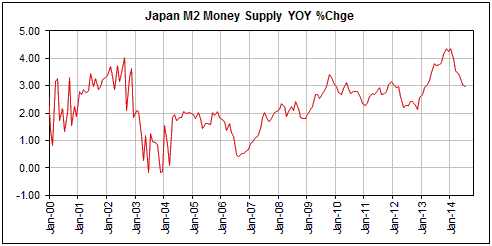A popular view is that the Bank of Japan (BOJ) is inflating the Yen to oblivion. This view is wrong. The reality is that while there is certainly a risk that the BOJ will eventually inflate Japan’s money supply at a fast pace, it is not currently doing so.
The spectacular QE program introduced by the BOJ in April of last year did have some effect on the money supply, but the effect was nowhere near as great as generally believed. As illustrated by the chart displayed below, the year-over-year (YOY) rate of increase in Japan’s M2 money supply rose from around 3% in early-2013 to just above 4% near year-end, but 4% is a long way from the explosive growth that most analysts thought would result from the BOJ’s new Yen-depreciation policy. Furthermore, the YOY rate of increase in Japan’s M2 has since drifted down to 3% and appears to be on its way back to the long-term average of 2% (I think it will be back at 2% by October). This means that Japan is still maintaining the world’s lowest monetary inflation rate, which prompts me to ask: Why are so many analysts still blindly assuming that the BOJ is rapidly expanding the Yen supply? Why aren’t they spending the 15 minutes that would be needed to validate — or in this case invalidate — their assumptions by checking the money-supply figures available at the BOJ web site?

An implication of the above is that the supply side of the Yen’s supply-demand equation remains bullish for the Yen’s exchange rate. However, for most currency traders this doesn’t matter. The reason is that the supply side dominates very long-term trends in the foreign exchange market, but the demand side often dominates over periods of up to 2 years.
 Print This Post
Print This Post
